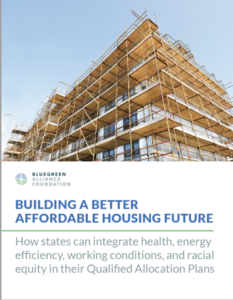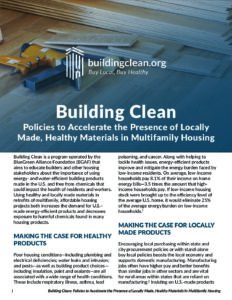Written by Michael Miranda and Linnea Morgan from the BlueGreen Alliance Foundation’s Building Clean initiative.
What is Zero Energy Ready?
Net-Zero Ready or Zero Energy Ready buildings are designed and built to meet a certain level of energy efficiency so that if a renewable energy system were installed, the building would then produce as much energy as it consumes. While a Net-Zero or Zero Energy building is an energy-efficient building with a renewable energy system installed that produces as much energy as it consumes.
Zero Energy and Zero Energy Ready buildings typically have very well insulated roofs, walls, and foundations, along with energy-efficient appliances, heating, ventilation, domestic hot water, lighting, and, if needed, air conditioning systems. Assuming a typical occupant’s energy consumption behavior, the end goal is the home’s utility bill showing zero energy consumption at the end of a year. The building’s designer works back from that goal.
If the building is tall and skinny, so that the relative roof space for a solar PV system is small compared to the size of the building, then a more efficient building is needed, which means more insulation and higher efficiency HVAC and hot water systems. However, if the relative roof space for a solar PV system is large, then a slightly less efficient building is fine (if cost-effective).
This is all determined by creating a building energy model, with all the numerous building components that impact the energy performance of the building included within the model, such as the type of construction and energy performance of the roofs, walls, foundations and windows, and the energy performance of the appliances, heating, ventilation, domestic hot water, and air conditioning systems.
Building Certifications
The U.S. Department of Energy has a Zero Energy Ready Homes program where participating homes are verified by a qualified third-party and are at least 40%-50% more energy-efficient than a typical new home. This DOE program generally corresponds to a Home Energy Rating System (HERS) Index Score in the low- to mid-50s, depending on the size of the home and the region in which it is built. The PHIUS Passive Building Standard goes beyond the Zero Energy Ready Homes program and requires an even more energy-efficient building. A true Zero Energy Home will have a HERS Index Score of around 0 by producing as much energy as it consumes.
Costs
A recent Rocky Mountain Institute report found that new zero energy homes are almost at cost parity, with a small incremental cost difference to code-built homes. In some areas of the United States, zero energy homes do not cost more to build.
Zero Energy Ready Strategies
Below are some strategies to successfully achieve Zero Energy Ready buildings, along with some real-world examples of Building Clean work with Flower City Habitat for Humanity.
Take Advantage of the Incentives: Your local energy efficiency incentive provider, which might be your utility company, city/town, or a state agency might provide incentives for building zero energy ready or zero energy buildings. Below are some resources to find incentives or rebates. If you can not find zero energy ready incentives, look for funding for achieving similar certifications that can provide you with some additional funding to get you there. Similar certifications include ENERGY STAR Certified Homes, ENERGY STAR Multifamily New Construction, LEED for Homes, LEED New Construction, National Green Building Standard, Enterprise Green Communities, or PHIUS Passive Building Standard.
Funding resources:
- Local and regional energy efficiency incentive providers, such as your utility company, city/town, and/or state agency
- New York State, through NYSERDA, offers Net-Zero rebates and smaller ENERGY STAR rebates. Both rebate amounts are increased for low-to-moderate-income housing. The NYSERDA Net-Zero rebate is $4,200 and the NYSERDA ENERGY STAR rebate is $1,700 for a single-family low-to-moderate-income home.
- In Michigan, Consumers Energy has a Zero Net Energy program
- The Energy Trust of Oregon offers incentives through their Path to Net Zero program
- The Zero Energy Ready Homes program has also compiled a list of some of the incentives available
- Database of State Incentives for Renewables & Efficiency (DSIRE)
- ENERGY STAR certified building incentives
- Energy efficiency incentive providers, such as utility companies, commonly provide custom rebates for commercial and industrial buildings, and it might be worth asking for a custom rebate based on the energy reduction you achieve beyond the minimum required by ENERGY STAR.
Expertise within the Project Team: Depending on the expertise within the project team, a green building consultant or HERS Rater might be useful, or potentially required if you are pursuing a certification that is required to receive an incentive. Local and regional energy efficiency incentive providers might provide funding to cover some technical assistance and/or testing the HERS Rater provides.
Very well insulated and air-sealed roofs, walls, and foundations are typical in zero energy and zero energy ready buildings due to insulation and air sealing being the most cost-effective measures for dramatically reducing the energy consumption of buildings. Air leakage not only allows indoor heated and cooled air to escape, but just as bad, air leakage through the insulation in the exterior walls, roof, and foundation reduces the effectiveness of the insulation dramatically.
There is a perception that spray foam insulation is needed to build a tightly air-sealed and highly efficient zero energy building, which is not the case at all. Spray foam insulation is not only expensive, it is the most hazardous type of insulation product, with various ingredients of concern that are hazardous to installers and occupants.
When renovating or building a new building, the design or on-site conditions can sometimes limit the amount of insulation you can add to the building. The building cavity might be smaller than expected or there isn’t sufficient access to properly insulate portions of the building. When this occurs, project teams might be tempted to use spray foam insulation to achieve the insulation value they wanted or are required to achieve due to building energy codes.
During Building Clean’s product consultation with Flower City Habitat for Humanity, Building Clean suggested using REScheck to avoid using the planned spray foam insulation and replacing it with common, less-expensive batt and rigid insulation, which resulted in savings of approximately $3,250 per home. Check-out our resource on How to Meet Building Energy Codes While Avoiding Costly & Hazardous 2-Part Spray Foam Insulation that explains how REScheck provides you with flexibility in meeting building energy codes, and allows you to avoid using hazardous spray foam insulation.
A well designed and tested ventilation system is important in every building, but even more so in tighter buildings. Tight buildings make typical exhaust-only ventilation even less effective since there is less air leaking into the building to replace the air that is trying to be pushed out. Balanced ventilation that brings in filtered, fresh air, while exhausting stale air at the same time, such as energy recovery ventilators (ERV) and similar heat recovery ventilators (HRV), are essential in highly efficient buildings.
Flower City Habitat for Humanity purchased American-made ERVs for $90 less than the major-brand foreign-made ERV they had started to install. The American-made ERV had easier to replace air filters, and, most importantly, it was more efficient when full energy performance was considered, both ventilation recovery efficiency and power consumption.
It is very important to right-size the HVAC system to ensure it operates at peak efficiency, short-cycling is reduced (increasing system life), and equipment costs reductions are also common. Load-sizing calculations, using ACCA Manual J and S, are completed to properly size the HVAC system for the building.
By right-sizing the HVAC equipment, Flower City reduced its HVAC equipment cost. However, this also reduced the heat pump energy efficiency rebate. This sometimes occurs when energy efficiency rebates are tied to the HVAC system capacity or size.
It is best to get multiple quotes for multiple competing products or models. To compare quotes, a higher efficiency product will have a higher SEER, CEER, EER, HSPF, AFUE, EF, or UEF efficiency rating.
After receiving a quote for one model of heat-pump hot water heaters, BGAF suggested getting another quote from a different brand with almost the same capacity (first-hour rating) that was American manufactured and had a higher efficiency rating (a higher UEF in this case). Flower City installed the American manufactured heat-pump hot water heater, while saving $300 per unit.
Getting to Zero Energy
The key here is the addition of a renewable energy system that will produce as much energy as the building consumes. Focus on three types of renewable energy systems, the very common solar photovoltaic (PV), thin-film solar PV, or large 100+ kW wind turbines, which are cost-effective systems with proven track records.
Funding resources:
- Local and regional renewable energy incentive providers, such as your city/town and/or state agency
- Database of State Incentives for Renewables & Efficiency (DSIRE)
- Non-profit organizations cannot take advantage of tax-based incentives, such as federal tax credits, so many have chosen to use common power-purchase agreements or lease structures to take advantage of those incentives.

 Building Clean’s “Buy Local, Buy Healthy” motto is a concept and approach to purchasing building products that focuses on supporting jobs in the local or regional economy, while lessening exposure to hazardous substances in the home through a better understanding of a product’s ingredient content and how it might impact the health of residents and installers. When applied in conjunction with building products that are energy and water-efficient, this concept can help transform lives and communities by creating buildings that save resources, grow jobs, and protect public health.
Building Clean’s “Buy Local, Buy Healthy” motto is a concept and approach to purchasing building products that focuses on supporting jobs in the local or regional economy, while lessening exposure to hazardous substances in the home through a better understanding of a product’s ingredient content and how it might impact the health of residents and installers. When applied in conjunction with building products that are energy and water-efficient, this concept can help transform lives and communities by creating buildings that save resources, grow jobs, and protect public health.